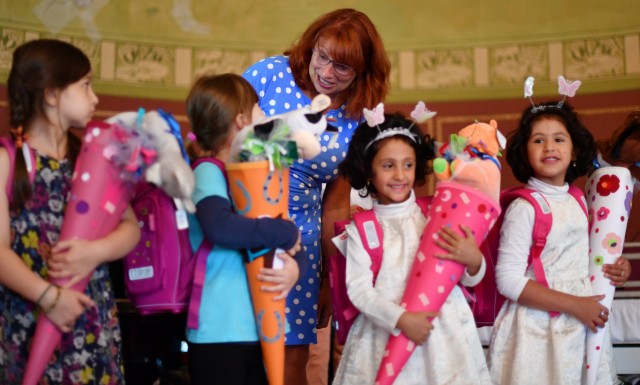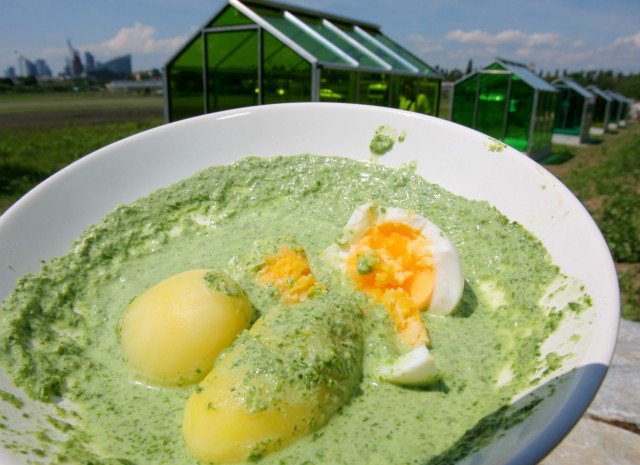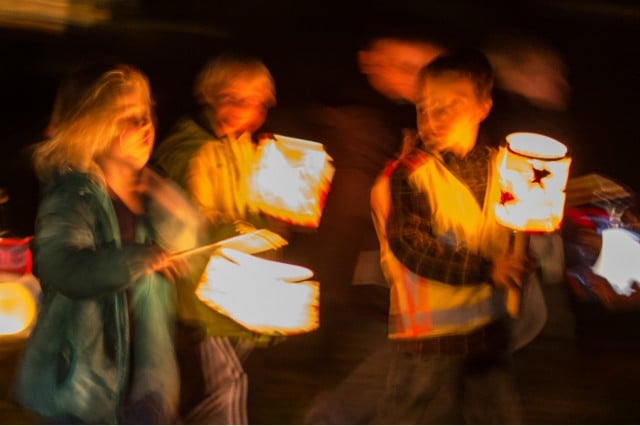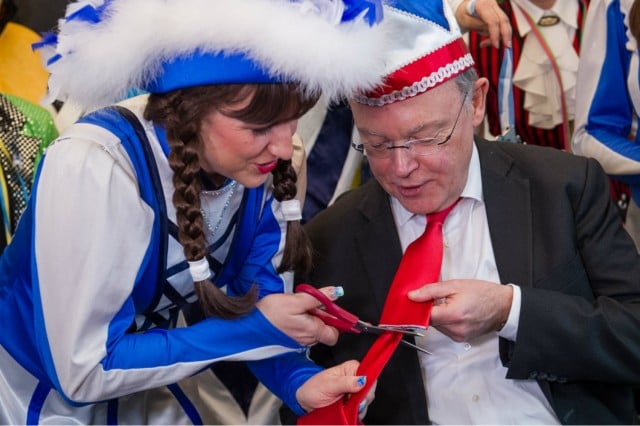8 quirky German customs you might never have heard of

Germany certainly knows how to celebrate special occasions, sometimes in rather weird and wacky ways. Here are eight seasonal customs which help to make German celebration days so special.
1. Giving children cones of sweets on their first day of school
 Photo: DPA
Photo: DPA
As part of perhaps Germany's most enviable school tradition, children are given large, brightly coloured cones filled with sweets on their first day of school. The cones, called Schultüten, are supposed to sweeten the deal of starting full-time education for unwilling first years.
The custom is almost 200 years old and legend goes that the sweets in the cones come from a sugar tree in the school basement, which has matured enough to be picked, just as the children are mature enough to begin school.
2. Running around the city dressed as Krampus
As you might know if you've seen the 2015 film, Krampus is Santa Claus' evil alter ego, who punishes bad children at Christmas time. Known by many names in German history including Klaubauf and Pelznickel, Krampus is a threat parents use to bring their badly behaved children into line.
Legend has it that, if you are naughty all year, on St Nicholas' day (6th December), Krampus will come and take you away to never be heard of again. This legend inspired yearly Krampusläufe or "Krampus walks", where people don masks and furry costumes and run about the streets as the evil demon.
For more than 500 years people have carried out Krampus runs in south Germany and Austria. If you are in Bavaria on December 6th you'll be sure to witness the action firsthand.
3. Smashing plates before a wedding
 Photo: Wikimedia Commons
Photo: Wikimedia Commons
There are a number of unusual German wedding traditions but one of the strangest is a pastime called the Polterabend, in which friends and family smash dinnerware to wish the couple luck in their marriage.
READ ALSO: 'Ja, ich will': What it's like to get married in Germany
The name Polterabend means "evening of crashing", and the hope is that, through the crashing of plates and dishes, demons will be scared away by the noise and the newlyweds will be able to live in peace.
For more weird and wonderful German wedding customs: click here
4. Having a massive Easter fire
 Photo: DPA
Photo: DPA
Unlike in England, you won't find any bonfires on Guy Fawkes Night on November 5th in Germany, but you will find them at Easter every year. The fires have both a Christian and pagan meaning and can be lit from Good Friday to Easter Sunday.
In parishes, the fires are lit on Holy Saturday and are then used to light the Easter candle, which is carried into the church. For Christians, the fire symbolizes the resurrection of Jesus, whereas in pre-Christian times the flames were supposed to drive the winter away.
Regardless of the original meaning, nowadays the fires are just a good way to get families and friends together and stay warm.
5. Eating green things on Maundy Thursday
 Photo: DPA
Although this custom has died out in recent decades, tradition dictates that on Gründonnerstag (Maundy Thursday) Germans should eat green food, be it vegetables, herbs or Frankfurt 'Green Sauce' (pictured above).
READ ALSO: German word of the day: Gründonnerstag
The 'Grün' in Gründonnerstag doesn't actually refer to the colour green, as the word comes from the verb 'greinen' which means to cry. Understandably, however, the Germans opted for a slightly more lighthearted custom than systematic crying on the day of Jesus' last supper.
6. Watching 'Dinner For One' on New Year's Eve
Photo: DPA
Although this custom has died out in recent decades, tradition dictates that on Gründonnerstag (Maundy Thursday) Germans should eat green food, be it vegetables, herbs or Frankfurt 'Green Sauce' (pictured above).
READ ALSO: German word of the day: Gründonnerstag
The 'Grün' in Gründonnerstag doesn't actually refer to the colour green, as the word comes from the verb 'greinen' which means to cry. Understandably, however, the Germans opted for a slightly more lighthearted custom than systematic crying on the day of Jesus' last supper.
6. Watching 'Dinner For One' on New Year's Eve
Every New Year's Eve, it is customary to watch this particular 1963 sketch - it is broadcast on most main German TV channels, including all three of ARD's NYE shows. The sketch is in English but was filmed in Hamburg by the NDR and features a butler humouring his rather senile mistress at a dinner party.
In 1988 the sketch broke the Guinness world record for the most repeated TV showings in the world. Despite its international success, the sketch never became popular in England but it is well loved and often reneacted across Germany and Austria.
7. Eating goose and joining a lantern procession for St Martin's day
 Photo: DPA
St. Martin lived from 317 to 397 A.D. and became Bishop of Tours. He is most beloved for his generous acts to help the poor and is therefore celebrated every year on November 11th.
On St Martin's day, Germans celebrate the saint with a procession of lanterns and singing before going home to eat goose, as the legend goes that St Martin was unwilling to become Bishop and so hid in a goose sty. The geese were not happy to be sheltering a fugitive, however, and squawked loudly, alerting the villagers out looking for him with lanterns. As a punishment to the unruly group of geese, roast goose is the dish of choice for the St. Martin's day festival.
8. Cutting off men's ties on women's carnival night
Photo: DPA
St. Martin lived from 317 to 397 A.D. and became Bishop of Tours. He is most beloved for his generous acts to help the poor and is therefore celebrated every year on November 11th.
On St Martin's day, Germans celebrate the saint with a procession of lanterns and singing before going home to eat goose, as the legend goes that St Martin was unwilling to become Bishop and so hid in a goose sty. The geese were not happy to be sheltering a fugitive, however, and squawked loudly, alerting the villagers out looking for him with lanterns. As a punishment to the unruly group of geese, roast goose is the dish of choice for the St. Martin's day festival.
8. Cutting off men's ties on women's carnival night
 Photo: DPA
The Thursday before Rosenmontag, Karneval's main parade, is Weiberfastnacht, or 'women's carnival night'. Tradition dictates that women can cut off any man's tie that is within their reach and can also kiss any man they want to. Women take scissors with them on their night out ready to snip away at any tie in sight.
This custom dates back to 1824 when women decided to storm the Bonn-Beuel city hall and trim a few centimetres off the ties of the men there.
Photo: DPA
The Thursday before Rosenmontag, Karneval's main parade, is Weiberfastnacht, or 'women's carnival night'. Tradition dictates that women can cut off any man's tie that is within their reach and can also kiss any man they want to. Women take scissors with them on their night out ready to snip away at any tie in sight.
This custom dates back to 1824 when women decided to storm the Bonn-Beuel city hall and trim a few centimetres off the ties of the men there.
Comments
See Also
1. Giving children cones of sweets on their first day of school
 Photo: DPA
Photo: DPA
As part of perhaps Germany's most enviable school tradition, children are given large, brightly coloured cones filled with sweets on their first day of school. The cones, called Schultüten, are supposed to sweeten the deal of starting full-time education for unwilling first years.
The custom is almost 200 years old and legend goes that the sweets in the cones come from a sugar tree in the school basement, which has matured enough to be picked, just as the children are mature enough to begin school.
2. Running around the city dressed as Krampus
 Photo: Wikimedia Commons
Photo: Wikimedia CommonsThere are a number of unusual German wedding traditions but one of the strangest is a pastime called the Polterabend, in which friends and family smash dinnerware to wish the couple luck in their marriage.
READ ALSO: 'Ja, ich will': What it's like to get married in Germany
The name Polterabend means "evening of crashing", and the hope is that, through the crashing of plates and dishes, demons will be scared away by the noise and the newlyweds will be able to live in peace.
For more weird and wonderful German wedding customs: click here
4. Having a massive Easter fire
 Photo: DPA
Photo: DPA

Every New Year's Eve, it is customary to watch this particular 1963 sketch - it is broadcast on most main German TV channels, including all three of ARD's NYE shows. The sketch is in English but was filmed in Hamburg by the NDR and features a butler humouring his rather senile mistress at a dinner party.
In 1988 the sketch broke the Guinness world record for the most repeated TV showings in the world. Despite its international success, the sketch never became popular in England but it is well loved and often reneacted across Germany and Austria.
7. Eating goose and joining a lantern procession for St Martin's day


Join the conversation in our comments section below. Share your own views and experience and if you have a question or suggestion for our journalists then email us at [email protected].
Please keep comments civil, constructive and on topic – and make sure to read our terms of use before getting involved.
Please log in here to leave a comment.